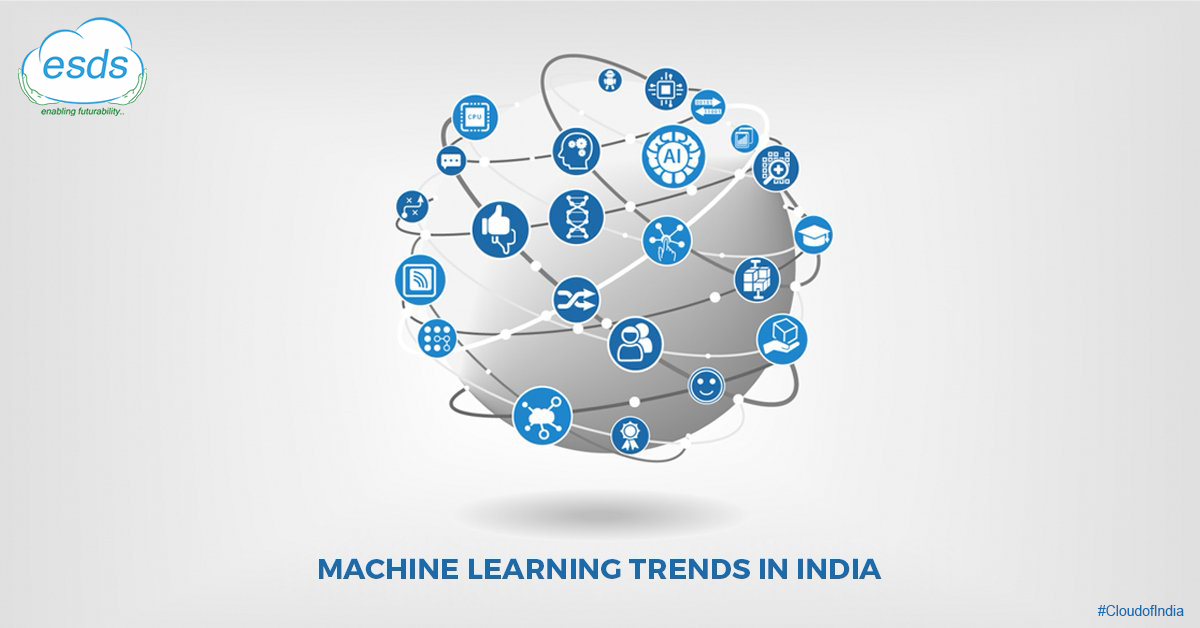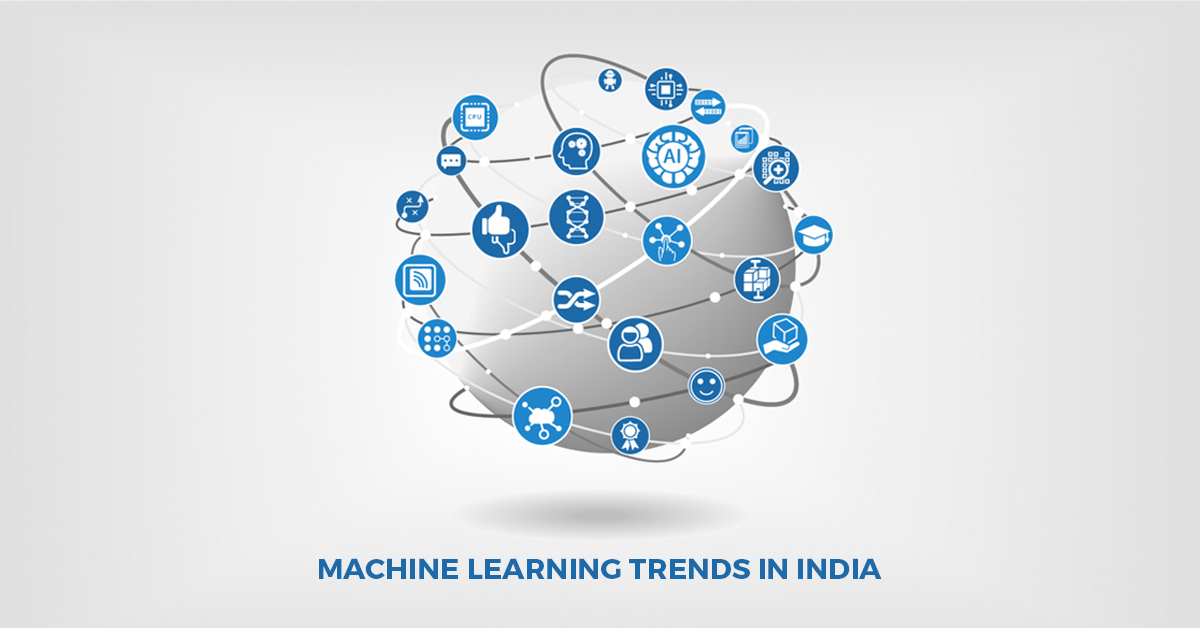Machine Learning Trends in India
Case 1: Netflix Using Machine Learning
There are different cases in which Netflix uses machine learning which has had a scalable impact leading to a permanent change in the technology landscape and user experience for many users. The adoption of AI-related solutions by Netflix is now growing stronger with time.

Some of the best Use Case of Machine Learning by Netflix includes the following-
i. Personalization of Movie Recommendations:
Netflix uses the watching history of other users who have a similar taste for recommending in what the user may be interested more in watching next, to engage the user and leading towards monthly subscriptions for more months to come
ii. Personalized Thumbnails and Artwork:
By using thousands of video frames from an existing movie or show, Netflix uses it as a starting point for the thumbnail generation. It also annotates the images and ranking of each image are done to identify the thumbnails that have the highest likelihood resulting from the user’s click. The calculations are based on what others are similar to the one clicked by use. One of the findings could include that the users who like a particular actor/movie genre are more likely to click those thumbnails which have similar actors or image attributes
iii. Post-Production of Movies (Movie Editing):
Use of historical data for cases of failure of quality checks in the past. Also, predicting in what cases, the manual checks would be most beneficial, which otherwise could be a very time consuming and laborious task
iv. Streaming Quality:
By the use of past viewing data, Netflix predicts the bandwidth usage for helping it in deciding when to cache the regional servers for fast load times especially during the peak or expected demand

Netflix in Indian Markets
Netflix saw an increase in its market share rising from 0.5% in the beginning of the year to 6.3% till October in the year 2018. In the year 2016, Netflix and Amazon Prime Video had an early-mover advantage, as the growth in these two have been primarily seen because of the expansive content they hold as well as the superior product that is being built on a mine of data and insights gained from the operations in other geographic locations.

(till October 2018)

(till November 2018)
Case 2: How Alexa Uses Machine Learning?
Whenever the user asks Alexa anything, the device records his voice and then this recording is sent over the Internet to Amazon’s Alexa Voice Services, parsing those recordings into commands that are understood by the Alexa. Once it is done, the system in Alexa sends the relevant output back to the device.
Data and machine learning form the foundation of Alexa and is gaining popularity over time. The amount of data being gathered by Alexa is also on the constant rise. Whenever there is a mistake or an error made by Alexa while interpreting the user request, the data is used for making the system smarter for the next uses. Machine learning is the key responsible factor for rapid improvements in the voice-activated user interface of Alexa. Alexa is based on Natural Language Processing (NLP)
It works as per following steps-
i. Amazon records the user’s voice and interpretation of sound can take up a lot of computational power and the recording of user’s speech is sent to Amazon’s servers that can be efficiently analysed
ii. Amazon breaks down the commands of the users into individual sounds and then consults a database that contains the pronunciations of various words for finding which words are most closely corresponding to the combination of these individual words
iii. Further, it identifies important words to make a sense of the tasks and carry out the corresponding functions
iv. The servers send the information back to the user’s device and thus, Alexa comes up with the results based on user’s query

(Source: https://www.amazon.com/HQTECHFLY-Security-Wireless-Multi-functional-Compatible/dp/B07D8SCQ81 )
Alexa in Indian Markets
Amazon has remained the market leader in the Indian smart speaker market with a share of 59% in the year 2018. A total of 753000 units were shipped in the last year. Google launched its devices in the second quarter of 2018, has managed to occupy 39% of market share in the given market segment. According to the International Data Corporation (IDC), Google’s Home Mini has outsold all other smart speaker models in the market, thereby emerging as the top-seller.


(Source: https://menafn.com/1098185597/India-Smart-Speakers-Market-2019-Global-Industry-Analysis-By-Size-Share-Growth-Factors-Competitive-Landscape-With-Regional-Forecast-To-2023)
Defining Machine Learning
Machine learning is considered to be an application of Artificial Intelligence that helps in providing systems the ability to learn automatically and improve based on the experience without any explicit programming. It focuses on the development of computer programs that access data and use it for their purposes. The process of learning starts with observing data, which could include direct experiences or instructions for determining the patterns in the data and making better decisions in the future, based on these examples. The primary aim of machine learning lies in allowing the computers to learn automatically without any human aid and adjust to the actions accordingly.
Machine Learning Methods
The machine learning algorithms are usually classified as either- supervised or unsupervised.
i. Supervised Machine Learning Algorithms:
These can be applied to the learning carried out in the past to new data by the use of labeled examples for predicting the events in the future. It starts from an analysis of a known training dataset, and the learning algorithm produces an inferred function for making predictions regarding the output values. The system can provide targets for newer inputs after enough training. The learning algorithm can also compare the output with a correct and intended output and even find errors to modify the model
ii. Unsupervised Machine Learning Algorithms:
These are used when the information used for training is neither classified nor labeled. The unsupervised learning studies how the functions would infer a function for describing a hidden structure from unlabelled data. The system is unable to figure out the right output, but is still able to explore the data and can draw inferences from the datasets used for describing the hidden structures from the unlabelled data
iii. Semi-supervised Machine Learning Algorithms:
In this type of learning method, the use of both- labeled and unlabeled data is used for training purposes. Usually, a small amount of labeled data and a large amount of unlabeled data is present. The systems using this method can considerably improve the accuracy in learning. This is chosen when the acquired data label requires the skilled as well as relevant resources to train or learn it. Acquisition of any unlabelled data doesn’t need any additional resources
iv. Reinforcement Machine Learning Algorithms:
It is a learning method that interacts with the environment by producing actions and discovers errors or rewards. The trial and error search and delayed reward are the most relevant characteristic of reinforced learning. This method allows machine and software agents to determine the ideal behavior within a specific context to maximize the performance. Simple reward feedback is required in case of agents who are learning regarding the best action, known as the reinforcement signal
Machine Learning Applications in 2019
Some of the machine learning applications that are going to dominate the 2019 market could include-
i. Virtual Agents:
Most of the businesses today use virtual agents for their customer services. Virtual agents are a machine-generated animated character who is responsible for emulating the role of a human customer service agent. The virtual agent is smart enough for providing initial support to any curious customer
ii. Natural Language Processing:
This technology is often used for converting the data into text and providing linguistic capabilities to a machine. The machines that are NLP-driven can interact in human language, which could be used in customer-service for generating feedback summaries and reports
iii. Image Recognition:
This is the capability that helps the machine to identify specific features in images, based on previous learning. This is widely used on social media platforms for a large number of searches
iv. Speech Recognition:
This technology is helping the machines to interact by the means of a human language. The voice-based systems such as Alexa are using speech recognition for interacting with mobile users
Upcoming Trends in Machine Learning
i. Augmented Analytics:
The augmented analytics use automated machine learning for the preparation of data, analytics, and business intelligence as well as automating the data science itself to reduce the need of expert analysts
ii. Sales Intelligence:
The organizations need to employ machine learning for understanding their customers and their behaviour to improve and launch new products and even tune their sales strategies. The collaborations of professionals with machine learning could be faster and lesser-time consuming. For an Indian market, both- B2B and B2C, with time it is becoming more competitive and the businesses must leverage the sales based on machine learning intelligence to hold the top position
iii. Automated Machine Learning:
The automated machine learning is going to be one of the leading machine learning-based solutions that are going to disrupt the market. Automated machine learning is going to empower the business analysts and developers for evolving the machine learning models which can address the complex scenarios without being involved through the typical process of machine learning training methods. When it comes to dealing with automated machine learning platforms, the business analysts need to stay focused on the business problems rather than getting drifted between the process and the workflow. Automated machine learning provides the right level of customizations, without asking the developers to go through the elaborated workflows
iv. Edge Computing:
Edge computing can be used for processing all those information, which are usually time-sensitive especially in the remote regions where there is no restricted network access to any centralized territory. In such cases, edge computing can act as little-scale servers
Machine Learning has seen promising and rising growth for the past two years. According to a Gartner prediction, it states that 85% of the operable market will use machine learning for the concepts of buy, build and outsourcing. With an estimated 80% involvement in the global market by the year 2020, Machine Learning is set to make a huge impact on the automation industry. It is evident now that most of the tech companies are improving as well as optimizing their products and services by the use of machine learning. It has become an important factor for analyzing and understanding the data being collected by the organizations, to empower their business as a whole. It would also be a challenge to see how machine learning creates an impact on humanity as a whole.
- Considering Data Centers in India to Overcome Economic Conditions - May 10, 2022
- Determining Why Your Organization Needs Web Application Security - February 11, 2022
- How Does a Business Benefit with Managed Services - January 21, 2022

